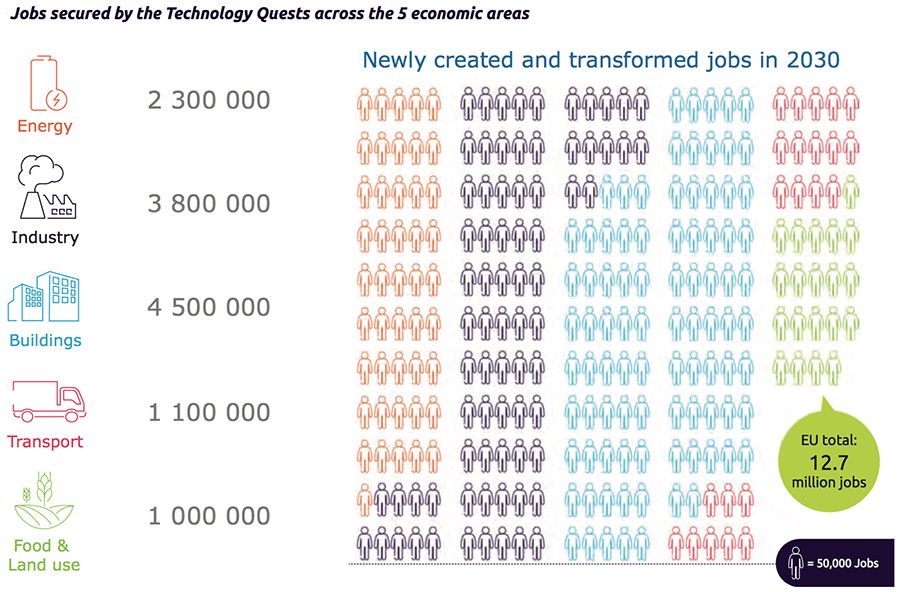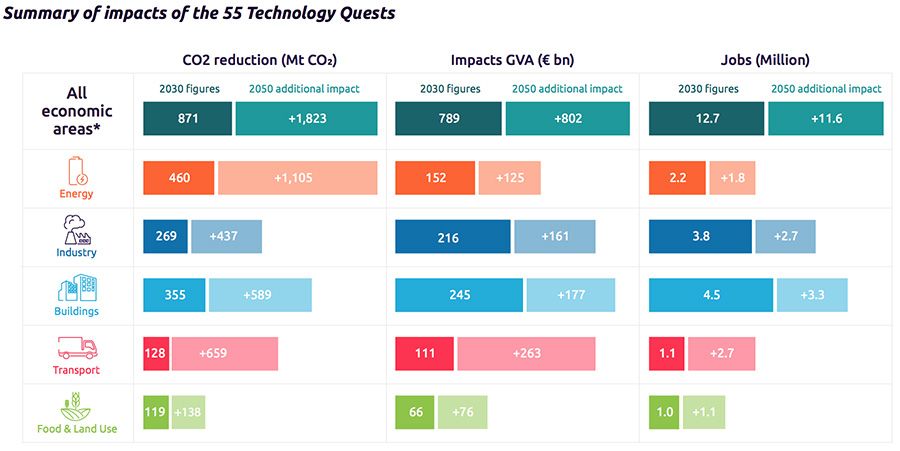Adopting clean technologies can add hundreds of billions to Europe’s economy by 2030, and trillions in the decades to follow, while at the same time slashing C02 emissions, according to a new Capgemini Invent report.
The research was commissioned by energy investment group Breakthrough Energy, set against the backdrop of billions being funneled into climate objectives by the European Union (EU). The goal: To paint a detailed picture of how these funds will tangibly help reduce emissions, or to chart an actionable roadmap to guide progress.
The EU’s long term budget for 2021 to 2027 features more than $500 billion to meet Europe’s climate change objectives – to cut emissions by 55% by 2030 and reach net zero emissions by 2050. The latter refers to a scenario where any carbon generated is offset completely by emission cuts in other operational areas.
Working on the knowledge that technology will play a key role in meeting these goals, Breakthrough Energy sought to find 50 plus fixes – labelled ‘Technology Quests’ – that can move Europe in the right direction. Capgemini Invent – a champion of low-emission modelsitself – was chosen to identify these Technology Quests, and came with a list of 55 high-impact initiatives across sectors.
Examples include: Developing new generation solar models; replacing concrete with carbon sink materials; shifting the European truck industry to green hydrogen; and developing sustainable farming techniques, among several others. “The selection process was based on a rigorous methodology and a comprehensive review of more than 200 state-of-the-art clean tech projects. Over 100 leading European experts from the private sector, government, NGOs and academia provided valuable input,” explained Capgemini Invent CEO Cyril Garcia.
Together, the emerging list of 55 quests represent big-ticket investments for Europe. The quests span the five economic areas of highest climate impact – energy, industry, buildings, transport, and food & land use. Given the right resources, these quests alone can deliver the 55% emission cut by 2030, and a carbon-neutral European economy by 2050.
The economic pay-back
According to Capgemini Invent, meeting these goals will require an annual investment of $144 billion into the quests – across public and private sources. No doubt, this is a hefty sum, although the potential economic returns on these investments might just create an adequate incentive. One is the sheer amount of jobs that can be created.

Provided that the adequate numbers flow in, the report suggests that nearly 13 million “high-quality and resilient jobs” could emerge, spread across the various impact industries. At a time when markets are grappling with the worst economic crisis in decades, job creation is a much-coveted outcome for most governments.
The researchers point out that clean tech such as green hydrogen is front and centre of many countries’ economic recovery package – France and Germany included – to the extent that it now precedes other political and investment objectives. Such a setup is sure to create thousands – if not millions – of job opportunities in decades to come.
Then there is the monetary value of investing in these 55 Technology Quests. By 2030, Capgemini Invent estimates that these quests will generate nearly $800 billion in gross value added, which pales in comparison to the $13 trillion that they could potentially generate between 2030 and 2050. In fact, for every €1 invested in the quests now, Europe could be gaining €9 by 2050.

Add to this the range of other benefits that simply facilitate a better, more sustainable life. These clean tech quests could cut down on air, water and noise pollution, while also improving food safety and quality. Europe, meanwhile, will emerge as an energy-independent tech leader in the global market. That being said, such a scenario is still dependent on investments flowing with the right volume and distribution.
An important note from the researchers is that the technologies being explored in the 55 quests are all at varying stages of maturity, which means that investments should be made using a portfolio approach rather than in individual quests. “A portfolio approach supports companies and employment across the full spectrum of the innovation cycle, from early-stage demonstration to late-stage deployment,” explained Garcia.
“A portfolio approach helps secure immediate benefits (emission reduction, jobs, economic recovery, etc.), while also diversifying risk and paving the way for long-term European leadership in the climate technology markets the world will rely on for decades to reach net-zero,” concluded Garcia.



















